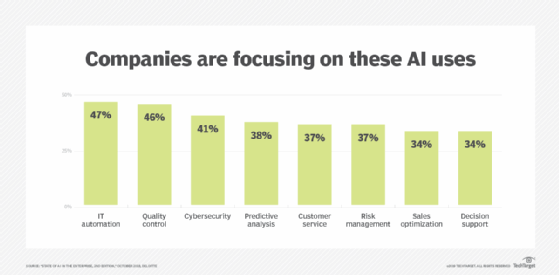
AI and IoT projects optimize industries inside and out
Organizations can reap greater rewards from the multiple ways AI and IoT technology can be used to improve supply chain processes, customer experiences and cybersecurity.
When people think of AI, it's easy to jump to the many possible uses seen in movies -- such as accessing secret areas with biometric data or robots completing human jobs -- but applying AI realistically requires architects and administrators to understand just how flexible AI is in a business setting.
Tech leaders have rapidly increased the number of AI and IoT projects in many areas of their businesses, including customer experience, data analysis and security. When organizations apply AI into these different aspects, they can more effectively process the IoT data they create and further improve their operations and products.
AI to improve the customer journey
Popular movies have made customer experience AI one of the better-known examples of AI. Ads may not be as flashy as the personally tailored ones using customer biometrics as seen in The Minority Report, but it's easy to see how organizations will get there from the online ads that use AI to give consumers offers specific to their interests. Businesses use AI that learns from data analytics on customer behavior throughout the IoT customer journey.
Within the retail industry, stores use facial recognition to speed up the payment process with biometric identity verification. AI tools process speech from smart assistants to help meet customers' needs. AI algorithms automate restocking supplies when IoT sensors indicate products are running low. When applied to data on customer behavior, AI makes sense of trends and creates algorithms to predict customer preferences and offer personalized recommendations. Organizations that apply AI to each of the different customer journey points will create a cohesive experience that adapts to consumers' wants and needs.
AI speeds up IoT data analysis
AI algorithms can reduce the demand that IoT data puts on cloud and edge computing. AI processing data in the cloud and at the edge makes real-time data analytics possible with lower latency and increased bandwidth and security. For example, organizations can apply AI and IoT projects at the edge for tasks such as preventative maintenance. IoT sensors record changing conditions and AI identifies patterns from the data, which can predict when machines will fail. Technicians can then fix the machines before a failure will cause major downtime.

AI algorithms can also identify places where processes could be better optimized, which might remain unseen to the human eye without the analysis of massive amounts of data. Applications that use AI can continuously learn from monitoring their own performance and self-optimize based on the data created.
At the edge, AI will process data from IoT sensors in real time, which is vital for applications such as virtual or augmented reality and self-driving vehicles. AI triggers the appropriate responses in complex event processing that depends on the context of events, such as the time of day or weather.
AI used for IoT security
The proliferation of IoT devices that organizations use complicates cybersecurity. IT pros must monitor the network traffic for unusual activity around communications, connections and policies. Organizations must proactively detect new threats, not just react to known ones. AI models can do so and step up any organization's security game. Even though traditional signature-based security platforms could detect threats, AI algorithms can process the massive amounts of IoT data and speed up the identification of anomalies from normal baseline behavior models. Through automation, AI can flag threats, investigate them further and prioritize risks. For example, AI algorithms should be able to detect if a request to configure an IoT device originated from an unusual account or at an unusual time and identify it as anomalous based on the typical patterns that the models identified from configuration data.
Security-based AI and IoT projects assist IT admins in detecting threats, such as identifying malware before malicious files are opened. Admins still have the ultimate say in how to handle threats or mark risks as a non-threat. Security experts can assign rules in AI algorithms to adapt to new insights. AI can remove repetitive security work, such as triaging low-risk alerts, leaving experts to focus on more vital decisions or threats. Security threats continue to evolve, and even hackers use AI to target organizations' networks and learn its weak points. With IoT deployments, organizations must also use AI to evolve.






